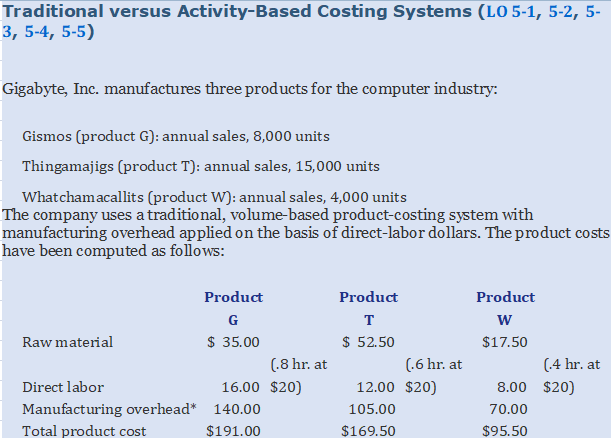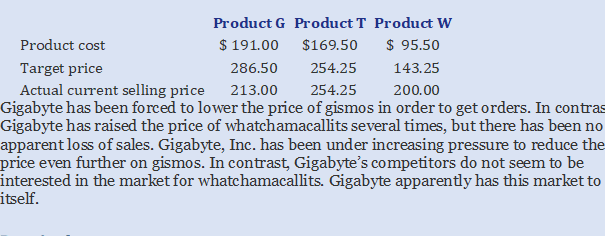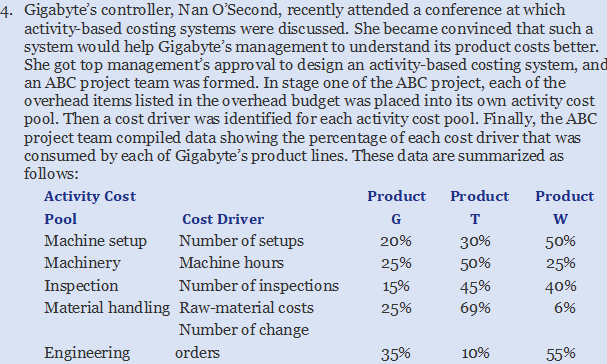


required:

Traditional versus Activity-Based Costing Systems (LO 5-1, 5-2, 5- 3,5-4, 5-5) Gigabyte, Inc. manufactures three products for the computer industry: Gismos (product G): annual sales, 8,000 units Thingamajigs (product T): annual sales, 15,000 units Whatchamacallits (product W): annual sales, 4,000 units The company uses a traditional, volume-based product-costing system with manufacturing overhead applied on the basis of direct-labor dollars. The product costs have been computed as follows: Product G Raw material $ 35.00 (.8 hr. at Direct labor 16.00 $20) Manufacturing overhead* 140.00 Total product cost $191.00 Product $ 52.50 (.6 hr. at 12.00 $20) 105.00 $169.50 Product w $17.50 (.4 hr. at 8.00 $20) 70.00 $95.50 *Calculation of predetermined overhead rate: Page 222 Manufacturing overhead budget: Machine setup $ 5,250 Machinery 1,225,000 Inspection 525,000 Material handling 875,000 Engineering 344,750 Total $ 2,975,000 Direct-labor budget (based on budgeted annual sales): Product G: 8,000 * $16.00 = $128,000 Product T: 15,000 $12.00 180,000 Product W: 4,000 $8.00 32,000 Total $340,000 Predetermined overhead rate = Budgeted overhead Budgeted direct labor=875%Predetermined over head rate = Budgeted overheadBudgeted direct labor=875% Gigabyte's pricing method has been to set a target price equal to 150 percent of full product cost. However, only the thingamajigs have been selling at their target price. The target and actual current prices for all three products are the following: Product G Product T Product W Product cost $ 191.00 $169.50 $ 95.50 Target price 286.50 254.25 143.25 Actual current selling price 213.00 254.25 200.00 Gigabyte has been forced to lower the price of gismos in order to get orders. In contras Gigabyte has raised the price of whatchamacallits several times, but there has been no apparent loss of sales. Gigabyte, Inc. has been under increasing pressure to reduce the price even further on gismos. In contrast, Gigabyte's competitors do not seem to be interested in the market for whatchamacallits. Gigabyte apparently has this market to itself. 4. Gigabyte's controller, Nan OSecond, recently attended a conference at which activity-based costing systems were discussed. She became convinced that such a system would help Gigabyte's management to understand its product costs better. She got top management's approval to design an activity-based costing system, and an ABC project team was formed. In stage one of the ABC project, each of the overhead items listed in the overhead budget was placed into its own activity cost pool. Then a cost driver was identified for each activity cost pool. Finally, the ABC project team compiled data showing the percentage of each cost driver that was consumed by each of Gigabyte's product lines. These data are summarized as follows: Activity Cost Product Product Product Pool Cost Driver G W Machine setup Number of setups 20% Machinery Machine hours 25% Inspection Number of inspections Material handling Raw-material costs 25% 69% 6% Number of change Engineering orders 35% 10% 55% 30% 50% 45% 50% 25% 40% 15% Traditional versus Activity-Based Costing Systems (LO 5-1, 5-2, 5- 3,5-4, 5-5) Gigabyte, Inc. manufactures three products for the computer industry: Gismos (product G): annual sales, 8,000 units Thingamajigs (product T): annual sales, 15,000 units Whatchamacallits (product W): annual sales, 4,000 units The company uses a traditional, volume-based product-costing system with manufacturing overhead applied on the basis of direct-labor dollars. The product costs have been computed as follows: Product G Raw material $ 35.00 (.8 hr. at Direct labor 16.00 $20) Manufacturing overhead* 140.00 Total product cost $191.00 Product $ 52.50 (.6 hr. at 12.00 $20) 105.00 $169.50 Product w $17.50 (.4 hr. at 8.00 $20) 70.00 $95.50 *Calculation of predetermined overhead rate: Page 222 Manufacturing overhead budget: Machine setup $ 5,250 Machinery 1,225,000 Inspection 525,000 Material handling 875,000 Engineering 344,750 Total $ 2,975,000 Direct-labor budget (based on budgeted annual sales): Product G: 8,000 * $16.00 = $128,000 Product T: 15,000 $12.00 180,000 Product W: 4,000 $8.00 32,000 Total $340,000 Predetermined overhead rate = Budgeted overhead Budgeted direct labor=875%Predetermined over head rate = Budgeted overheadBudgeted direct labor=875% Gigabyte's pricing method has been to set a target price equal to 150 percent of full product cost. However, only the thingamajigs have been selling at their target price. The target and actual current prices for all three products are the following: Product G Product T Product W Product cost $ 191.00 $169.50 $ 95.50 Target price 286.50 254.25 143.25 Actual current selling price 213.00 254.25 200.00 Gigabyte has been forced to lower the price of gismos in order to get orders. In contras Gigabyte has raised the price of whatchamacallits several times, but there has been no apparent loss of sales. Gigabyte, Inc. has been under increasing pressure to reduce the price even further on gismos. In contrast, Gigabyte's competitors do not seem to be interested in the market for whatchamacallits. Gigabyte apparently has this market to itself. 4. Gigabyte's controller, Nan OSecond, recently attended a conference at which activity-based costing systems were discussed. She became convinced that such a system would help Gigabyte's management to understand its product costs better. She got top management's approval to design an activity-based costing system, and an ABC project team was formed. In stage one of the ABC project, each of the overhead items listed in the overhead budget was placed into its own activity cost pool. Then a cost driver was identified for each activity cost pool. Finally, the ABC project team compiled data showing the percentage of each cost driver that was consumed by each of Gigabyte's product lines. These data are summarized as follows: Activity Cost Product Product Product Pool Cost Driver G W Machine setup Number of setups 20% Machinery Machine hours 25% Inspection Number of inspections Material handling Raw-material costs 25% 69% 6% Number of change Engineering orders 35% 10% 55% 30% 50% 45% 50% 25% 40% 15%










